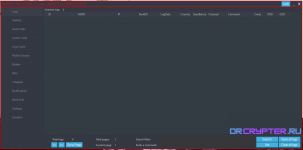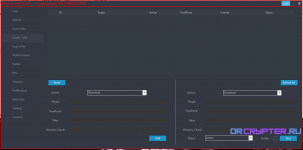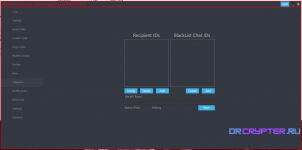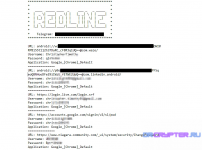Redline Botnet is the best botnet and has awesome features with stealers.
Redline has many features, and this botnet is very popular, and many hackers were using it to steal accounts, cookies, credit cards, crypto wallets (core software), and much more. This one can also be used by hackers using redline, and some tools called cookies checker combine them very well!






Password ZIP : drcrypter.ru
Redline has many features, and this botnet is very popular, and many hackers were using it to steal accounts, cookies, credit cards, crypto wallets (core software), and much more. This one can also be used by hackers using redline, and some tools called cookies checker combine them very well!






RedLine Data Stealing
The first and foremost capability of the RedLine Stealer is reconnaissance of the environment it is running in. It is not about anti-detection and anti-analysis tricks, but about having a full footprint of a system. Malware is capable of this action even when it receives a blank configuration from the C2, i.e., it is its basic functionality.
Time Zone
Languages
Hardware information
Username
Windows version and build
Screenshot
Installed browsers
Installed antivirus software
Currently running processes
Using configurations, however, RedLine Stealer can grab a much wider range of data, including passwords of different categories, bank card numbers, and cryptocurrency wallets, as well as data from web browsers and several specific desktop applications. Let’s take a look at each data source.
Web browsers
RedLine can break into numerous web browsers, from the ever-loved ones, like Chrome, Opera, and Firefox, to alternatives based on Chromium and Quantum. Key points of interest there are divided into in-browser data and data from add-ons related to cryptocurrency wallets. The stealer can steal saved passwords and credit card data from AutoFill forms. Actually, it can grab whatever it finds in auto-fill, since this is its main way of stealing data from browsers. Another thing RedLine Stealer seeks in web browsers is cookies. Depending on the way the browser stores cookies (i.e., as an encrypted file or within an SQL database), malware can extract them as well.
Browser extensions are a bit of a different story. Malware brings a hefty list of extensions that are used to manage hot cryptocurrency wallets. Malware scans web browser files in order to locate some of them. Then it dumps data related to all the matches (or skips if none are found). It specifically aims at passwords and cookies related to these extensions, copying whatever it locates to its folder with files. The list of wallets it targets is as follows:
Desktop applications
There are three desktop programs that RedLine Stealer pays specific attention to. Those are Discord, Steam, and Telegram Messenger. The primary target is session hijacking and stealing files related to sessions (in Telegram). The first and second ones have similar session management methods based on tokens. When attacking them, malware goes to their directories in AppData. Roaming and rummaging through their files, searching for session tokens. Malware knows the naming pattern used by both Steam and Discord, and it searches specifically for files that fit this naming convention.
Telegram has a different mechanism for session handling that does not allow the same trick. For that reason, RedLine Stealer only grabs all possible files related to the user session stored in the AppDataTelegram Desktoptdata folder.
VPN and FTP applications
RedLine is capable of stealing login credentials for several VPN services and FTP applications. Those are OpenVPN, NordVPN, ProtonVPN, and FileZilla. For VPNs, it simply searches for configuration files in their user directories. For example, to grab the users’ data in NordVPN, it searches its directory, AppDataLocalNordVPN, and searches for.config files. In these files, it looks for nodes "//setting/vvalue".
The first and foremost capability of the RedLine Stealer is reconnaissance of the environment it is running in. It is not about anti-detection and anti-analysis tricks, but about having a full footprint of a system. Malware is capable of this action even when it receives a blank configuration from the C2, i.e., it is its basic functionality.
Time Zone
Languages
Hardware information
Username
Windows version and build
Screenshot
Installed browsers
Installed antivirus software
Currently running processes
Using configurations, however, RedLine Stealer can grab a much wider range of data, including passwords of different categories, bank card numbers, and cryptocurrency wallets, as well as data from web browsers and several specific desktop applications. Let’s take a look at each data source.
Web browsers
RedLine can break into numerous web browsers, from the ever-loved ones, like Chrome, Opera, and Firefox, to alternatives based on Chromium and Quantum. Key points of interest there are divided into in-browser data and data from add-ons related to cryptocurrency wallets. The stealer can steal saved passwords and credit card data from AutoFill forms. Actually, it can grab whatever it finds in auto-fill, since this is its main way of stealing data from browsers. Another thing RedLine Stealer seeks in web browsers is cookies. Depending on the way the browser stores cookies (i.e., as an encrypted file or within an SQL database), malware can extract them as well.
Browser extensions are a bit of a different story. Malware brings a hefty list of extensions that are used to manage hot cryptocurrency wallets. Malware scans web browser files in order to locate some of them. Then it dumps data related to all the matches (or skips if none are found). It specifically aims at passwords and cookies related to these extensions, copying whatever it locates to its folder with files. The list of wallets it targets is as follows:
Desktop applications
There are three desktop programs that RedLine Stealer pays specific attention to. Those are Discord, Steam, and Telegram Messenger. The primary target is session hijacking and stealing files related to sessions (in Telegram). The first and second ones have similar session management methods based on tokens. When attacking them, malware goes to their directories in AppData. Roaming and rummaging through their files, searching for session tokens. Malware knows the naming pattern used by both Steam and Discord, and it searches specifically for files that fit this naming convention.
Telegram has a different mechanism for session handling that does not allow the same trick. For that reason, RedLine Stealer only grabs all possible files related to the user session stored in the AppDataTelegram Desktoptdata folder.
VPN and FTP applications
RedLine is capable of stealing login credentials for several VPN services and FTP applications. Those are OpenVPN, NordVPN, ProtonVPN, and FileZilla. For VPNs, it simply searches for configuration files in their user directories. For example, to grab the users’ data in NordVPN, it searches its directory, AppDataLocalNordVPN, and searches for.config files. In these files, it looks for nodes "//setting/vvalue".
Warning : my link was clean file 100% but I still recommend you using VM or Sandboxie and RDP to install this program or script
Download must link with earn money for stored long life link without dead hope you enjoy and agree thank so much
Download must link with earn money for stored long life link without dead hope you enjoy and agree thank so much
Password ZIP : drcrypter.ru
Last edited:


